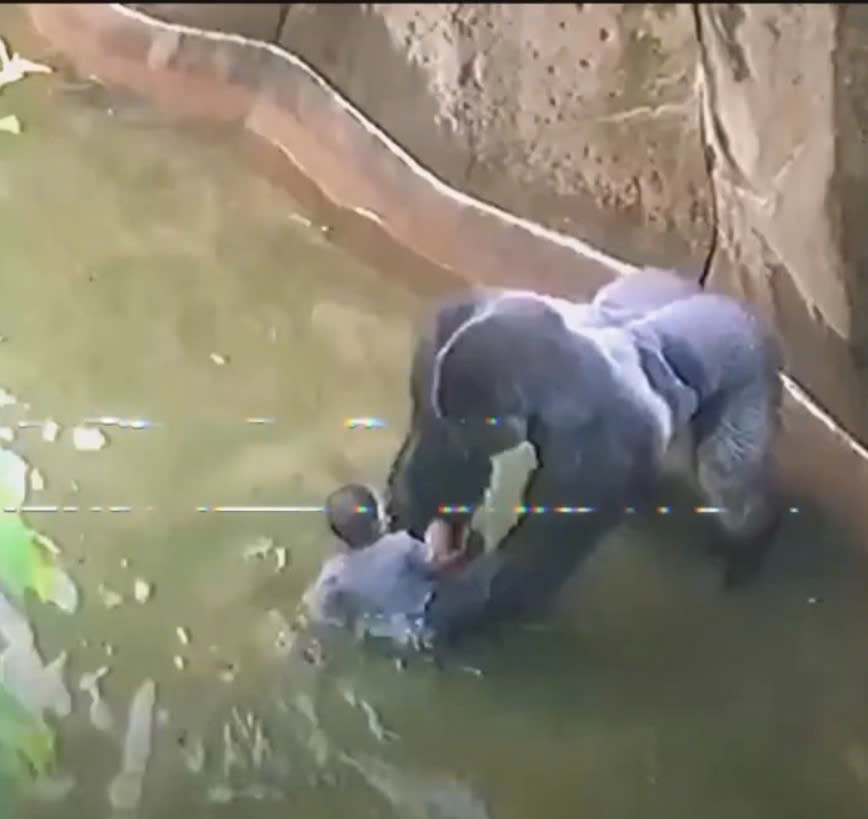Almost a decade later, the name Harambe still stirs emotions that run deeper than a viral memory. His story has become more than an incident—it’s a touchstone for discussions about ethics, animal behavior, and the delicate boundary between human safety and wildlife conservation. The images of that day in 2016 continue to haunt those who have watched the footage, sparking debates that refuse to fade. Was the gorilla acting out of aggression, or was he misunderstood in a moment of chaos and fear? What happened inside that enclosure for those tense few minutes changed the way the world viewed zoos forever.

On May 28, 2016, at the Cincinnati Zoo and Botanical Garden, a three-year-old boy slipped through a barrier and fell into the gorilla enclosure, landing in a shallow moat just a few feet from Harambe—a 17-year-old, 440-pound western lowland gorilla. Witnesses recalled the gasps, the screams, and the split-second panic that rippled through the crowd. Within moments, zoo staff were faced with an impossible decision: act swiftly to save the child or risk the child’s life in the hope that the situation could be de-escalated. The choice they made—to fatally shoot Harambe—would ignite a global firestorm that still burns today.
The official account from the Cincinnati Zoo stated that Harambe was dragging and handling the child in a way that posed imminent danger. But for millions who saw the footage later, the interpretation wasn’t so clear-cut. Some saw aggression; others saw curiosity or even a form of protection. Harambe appeared at times calm, at times forceful—holding the child by the leg and then standing over him as if guarding him. Behaviorists who analyzed the video remain divided. Some experts argued that Harambe was exhibiting a protective instinct, noting his posture and lack of overt violence. Others countered that even if his intentions were not hostile, a silverback gorilla’s immense strength meant that a single movement could have been fatal.
Zoo officials emphasized that tranquilizers were not an option. Sedatives take time to work, and in those critical seconds, Harambe’s alertness could have turned deadly before the drug took effect. The decision to use lethal force, while heartbreaking, was made to save the child’s life—a decision that zoo director Thane Maynard described as both devastating and necessary. “It was a tragedy,” he said, “but the child’s safety had to come first.” Still, for many observers, the tragedy was compounded by the feeling that Harambe had paid the ultimate price for human error.
The public outcry was immediate and immense. Social media exploded with grief and outrage. Hashtags, petitions, and heated debates filled timelines across the world. Within days, “Justice for Harambe” became a rallying cry, blending genuine sorrow with internet culture’s tendency to turn tragedy into symbol and satire. But beyond the memes and viral moments, the world was grappling with serious questions about responsibility, ethics, and our relationship with the natural world.
In the months following Harambe’s death, zoos across the globe reevaluated their safety measures. Barriers were reinforced, viewing areas redesigned, and staff retrained to prevent similar incidents. Many institutions also began more earnest discussions about whether wild animals—especially intelligent, socially complex species like gorillas—should continue to live in captivity at all.
Animal rights advocates used Harambe’s death as a rallying point, arguing that no amount of safety design could make captivity truly humane. They emphasized that gorillas, who share 98% of their DNA with humans, experience emotion, grief, and stress just as people do. To them, Harambe’s final moments were not only tragic but also symbolic—a reminder of what happens when wild beings are confined for human entertainment or education. “It wasn’t just an accident,” one animal rights advocate said. “It was a reflection of how far we’ve drifted from understanding and respecting the animals we claim to love.”
On the other hand, defenders of modern zoos made an equally passionate case. They argued that zoos serve vital roles in conservation, research, and education. Many species that might otherwise be extinct—such as the California condor and the black-footed ferret—have survived thanks to captive breeding programs. Zoos, they contended, are no longer simply entertainment centers but hubs for preserving biodiversity. They also reminded critics that millions of visitors leave zoos inspired to support conservation efforts, having developed a personal connection to animals they might never encounter otherwise.
Still, Harambe’s story forced even zoo supporters to acknowledge the ethical gray area in which their institutions operate. How much risk to human safety is acceptable in preserving the dignity of an animal’s life? Should the instinct to protect human life always outweigh the value of an animal’s existence? The debate blurred the lines between empathy, fear, and responsibility, prompting introspection across professional fields—from zookeepers to ethicists, from parents to policymakers.
Even years later, the Cincinnati Zoo continues to feel the impact of that day. Officials have since made significant upgrades to the Gorilla World exhibit and established new policies regarding visitor barriers. The zoo’s staff has repeatedly expressed heartbreak over Harambe’s loss, reminding the public that those who made the decision also loved and cared for him deeply. “We lost a member of our family that day,” one zookeeper said. “No one who worked with Harambe will ever forget him.”
What has endured most is the symbolic weight of his name. Harambe became more than a gorilla—he became a cultural reference point, a moral question, and even a reflection of how humanity sees itself in the mirror of nature. To some, he represents the failure of human systems to protect both people and animals. To others, he is a martyr of misunderstanding—a victim of circumstances that spiraled too quickly for compassion to prevail.
Nearly ten years on, Harambe’s story continues to echo through public consciousness. His death reminds us that our encounters with wild animals, even within the controlled environments of zoos, carry profound responsibility. It challenges us to consider how we coexist with creatures whose strength, intelligence, and instincts we can never fully grasp. His story also underscores how digital culture amplifies tragedy—how one moment of crisis can ripple outward, transforming grief into activism, humor, and reflection all at once.
In the end, the legacy of Harambe is not one of blame, but of awareness. It forces us to confront the uneasy truth that human curiosity and compassion can sometimes collide with our instinct to control. His death is a lasting call to rethink how we treat the animals that share our planet—whether they live behind glass, in sanctuaries, or in the diminishing wild.
Harambe’s name endures not only as a viral symbol but as a somber reminder of the fragile balance between human life and animal welfare. The events of that day at the Cincinnati Zoo remain a point of reflection for anyone who believes that compassion should guide our choices. Perhaps the true lesson of Harambe’s story is that coexistence demands humility—that even in our efforts to protect, we must never forget to respect





